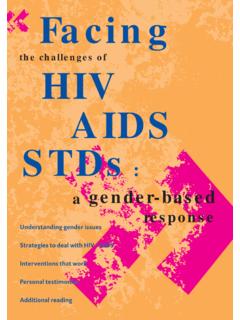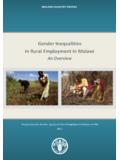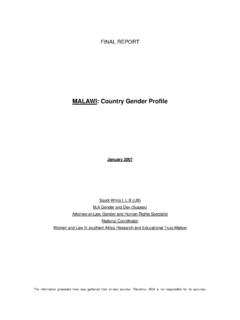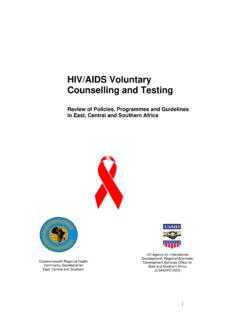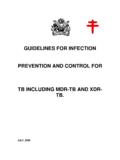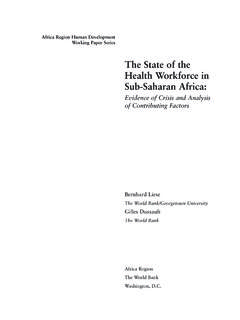Transcription of Draft for Discussion - UNICEF
1 Draft for Discussion 1 For additional information on the paper, please contact: UNICEF (United Nations Children s Fund), Chewe Luo, email: Draft for Discussion 2 Introduction 1. The global context The Global Plan towards the elimination of new HIV infections among children by 2015 and keeping their mothers alive is well underway, with ambitious goals of reducing the number of new HIV infections in children by 90% and HIV-related maternal deaths by 50%.1 There is now unprecedented collaboration and political will to accomplish these goals, and many countries have made exceptional progress. According to UNAIDS estimates, in 2011 57% of pregnant women living with HIV in low and middle-income countries received effective antiretroviral drugs for prevention of mother to child transmission (PMTCT), a substantial increase from 48% in Nonetheless, many implementation challenges remain, and chief among them is ensuring that high proportions of women and children in need of antiretroviral therapy (ART) can access it.
2 Global access to ART among pregnant women in need was lower than access among adults in the general population at 34% vs. 47% in 20103, far from the Global Plan target of 90% ART access by 2015. Low access of pregnant women to ART exists despite the fact that coverage of HIV testing is generally much higher in pregnant women than other adult populations. While poor ART access for pregnant women is a pervasive problem for many PMTCT programs, it disproportionately affects women and children living in areas far from ART sites or in settings with weak health systems. An AIDS-free generation is within reach. But to achieve this goal, all partners will need to redouble their efforts and boldly move forward, rather than shrinking back in the face of challenges.
3 Reaching the hardest-to-reach women and children with ART will require thinking outside of the box to take implementation to a higher level of efficiency and effectiveness. Indeed, limited resources and pressing needs for broader maternal, neonatal and child health (MNCH) require that HIV programs maximize not only cost-effectiveness, but also benefits for other health programs. Clearly, a true game-changer is needed: an implementation modality for PMTCT that is at once both simpler and better than the current approaches. Is this possible? The great news is: yes! A new approach called Option B+ has already begun to show impressive results in real world , resource-constrained settings, dramatically increasing the numbers of pregnant women enrolling on ART.
4 The tide is turning - now is the time to move with the momentum and embrace a bold public health approach to effectively eliminate new paediatric HIV infections. 2. Options B and B+: a simplified approach to integrated PMTCT & ART at the primary care level What are Options B and B+? Under WHO s 2010 PMTCT ARV guidance, countries had the option to choose between two prophylaxis regimens for pregnant women living with HIV with CD4 greater than 350 cells/mm3: Option A and Option B. 4 Under Option A, women receive antenatal and intrapartum antiretroviral prophylaxis along with an antiretroviral postpartum tail regimen to reduce risk of drug resistance, while infants receive postpartum antiretroviral prophylaxis throughout the duration of breastfeeding.
5 Option B, on the other hand, has a simpler clinical flow in which all pregnant and lactating women with HIV initially are offered ART beginning in the antenatal period and continuing throughout the duration of breastfeeding. At the end of breastfeeding those women who do not yet require ART for their own health would discontinue the prophylaxis and continue to monitor their CD4 count, eventually re-starting ART when the CD4 falls below 350 cells/mm3. Along with these two options a third approach is now being used, Option B+, in which all pregnant women living with HIV are offered life-long ART, regardless of their CD4 count. Table 1 below, adapted from WHO, summarizes these three different options. Draft for Discussion 3 Option B+ was first conceived and implemented in malawi where the national ART program had already been functioning well using a public health approach which did not depend heavily on CD4 testing to determine who should initiate treatment.
6 malawi envisioned that Option B+ would be easier to implement due to its simple one size fits all approach which would enable women to access ART at high levels even in settings with poor access to CD4 testing. The early experience with Option B+ in malawi has borne this out, being extraordinarily successful, with a more than five-fold increase in the numbers of pregnant women being enrolled on ART in only the first quarter of full nationwide 6 Importantly, implementation of Option B+ in malawi involved much more than a change in antiretroviral regimen. Option B+ was part of a larger strategy in which malawi s ART and PMTCT programs fully integrated with one another so that ART could be administered by nurses at primary care facilities where women and children were already accessing MNCH services.
7 Using this equity-focused approach, malawi has been able to rapidly expand access to ART for pregnant women in hard-to-reach areas throughout the country. In April 2012, in response to malawi s early success and other strategic and technical developments, WHO released an important programmatic update on the Use of Antiretroviral Drugs for Treating Pregnant Women and Preventing HIV Infection in Infants 7 in which it urged countries to consider what the advantages of Options B and B+ may be in their contexts, stating: Options B and specifically B+ seem to offer important programmatic and operational advantages and thus could accelerate progress towards eliminating new paediatric infections.
8 Along with discussing the potential operational benefits due to greater simplicity of Option B and B+, WHO s programmatic update also emphasizes that Option B+ in particular may have significant additional advantages beyond PMTCT. These include providing better protection for maternal health and greater reduction 1 This table is adapted in a slightly modified form from a Table 1 in WHO s 2012 programmatic update: Use of Antiretroviral Drugs for Treating Pregnant Women and Preventing HIV Infection in Infants , available at Table 1: Three Options for PMTCT1 Treatment (for CD4 count < 350 cells/mm3) Prophylaxis (for CD4 count> 350 cells/mm3) Infant receives Option A Triple ARVs starting as soon as diagnosed, continued for life Antepartum: AZT starting as early as 14 weeks gestation Intrapartum: at onset of labour, single-dose NVP and first dose of AZT/3TC Postpartum.
9 Daily AZT/3TC through 7 days postpartum Daily NVP from birth until 1 week after cessation of all breastfeeding; or, if not breastfeeding or if mother is on treatment, through age 4 6 weeks Option B Triple ARVs starting as soon as diagnosed, continued for life Triple ARVs starting as early as 14 weeks gestation and continued intrapartum and through childbirth if not breastfeeding or until 1 week after cessation of all breastfeeding Daily NVP or AZT from birth through age 4 6 weeks regardless of infant feeding method Option B+ Triple ARVs starting as soon as diagnosed, continued for life Triple ARVs starting as soon as diagnosed, continued for life Daily NVP or AZT from birth through age 4 6 weeks regardless of infant feeding method Draft for Discussion 4 in the sexual transmission of HIV than other options.
10 While acknowledging the additional cost of Option B+ in terms of drugs, WHO notes that the cost of a simplified first-line once-daily regimen of efavirenz/TDF/3TC has decreased substantially, and that the overall cost-effectiveness of Option B and B+ are likely to be greater than Option A. However, the update also makes it clear that adopting Option B or B+ is no easy fix for PMTCT, and that ultimate success of Option B+ in particular will require an increased investment in interventions to improve long-term ART adherence and retention. Intensified support is also needed for other aspects of PMTCT programs beyond ART, including ensuring support for safe breastfeeding for HIV-exposed infants. Importantly, the WHO update also highlights how options B and B+ fit into larger HIV initiatives and opportunities.










